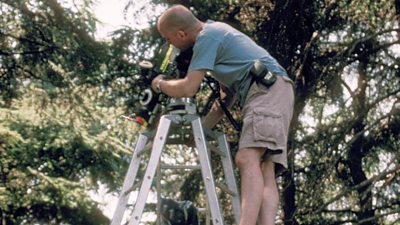What Can Go Wrong?
- Manual handling injury – they can be heavy and awkward to erect and position
- Trapping injury – fingers and hands can get caught in the sliding sections
- Falls from height - you could fall from one if you lose your balance / footing, it collapses or overturns, or if it is struck (e.g. by a vehicle)
- Struck by falling objects – items may fall from the ladder pod or it could collapse.
Legal/91�ȱ� Requirements
- Ensure work at height is properly planned and organised
- Those involved in work at height are competent
- Risks from work at height are assessed, and appropriate work equipment is selected and used
- Equipment used for work at height is properly inspected and maintained.
Control Measures
Planning your work at height
- Through risk assessment decide whether a ladder pod is the most suitable means of working/ filming at height.
- Source the ladder pod from a reputable supplier – avoid ‘home-made’ versions
- Ladder pods need to be supervised by a competent person – they should know how to safely erect it, know it's load bearing capability, inspect it before use and supervise those using it.
- Those using it need to be fit and well, and must not have a fear of heights.
Ladder pod erection / dismantling
- Locate ladder pods away from pedestrian or vehicular routes, or other obstructions.
- Minimise the distance of carry - move it in sections rather than as a complete structure.
- At least three fit and strong persons will be needed to erect, move and dismantle it.
- Whilst they can stand on uneven ground, they must be stable and the top plate level.
- Once erected, ensure safety ties and locks are in place to prevent collapse.
Ladder pod use
- Those climbing the ladder pod are to wear sturdy footwear with good grips
- Items which could fall should be secured in zipped pockets, bags or be tethered
- Raise and lower equipment on to the ladder pod by passing it from hand to hand – all should maintain 3 points of contact at all times.
- Except for those needing to 'foot' the ladder pod, maintain an exclusion zone around the base of the ladder pod.
- Sound/ vision cables should be managed to prevent them being snagged/ pulled
- Once persons are aloft, the ladder pod must not be adjusted or moved
- Minimise length of time spent aloft - ideally this should not be more than 30 minutes at a time.
- Do not tie-in the ladder pod - should it fall/ collapse, it is best to be thrown or jump clear.
- Avoid using the ladder pod in high winds or particularly wet/ cold conditions.
Documentation
- Ensure that you have assessed work at height risks in your programme risk assessment, including identifying any deviations from recognised good practice described above.
Division Specific Issues
- No division specific issues.
FAQs/Did You Know?
- Falls from height regularly top the list of causes of serious workplace accidents.
- As a rough guide for an unsecured ladder-pod, the maximum height should not exceed x2 it’s base spread dimension.
- Ladder pods come in various designs, some with simple rungs, others with adjustable platforms to stand on.
Recommended links
Working at Height topics
-

General
Guidance to assist planning, conducting or managing staff who are working at height -
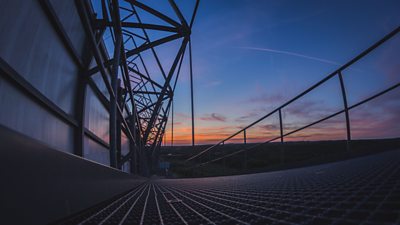
Gantries & High Level Platforms
Guidance on media positions within stadiums and arenas -

Ladders
Guidance on ladders to work up to approx. 6m high -

Ladder Pods
Guidance on ladder pods to work up to 5m high -
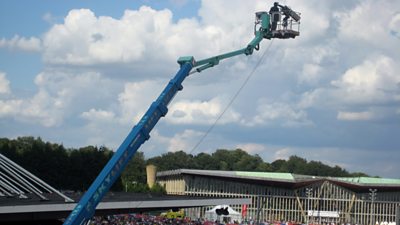
Mobile Elevating Work Platforms
Guidance on mobile elevating work platforms (MEWP) such as cherry pickers and scissor lifts. -
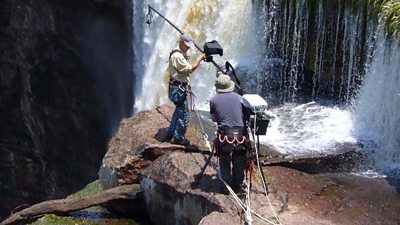
Rope Access Techniques
The equipment and techniques required to protect those working at or near exposed drops. -
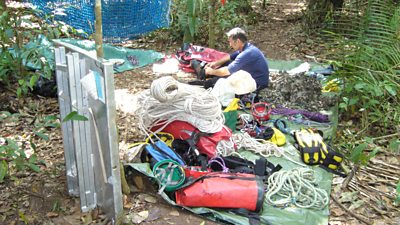
Ropes Riggers: Selection of
Competence criteria for the various professional Ropes Riggers. -
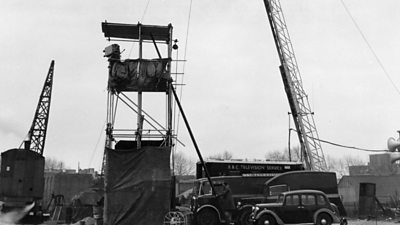
Tower Scaffolds
Guidance on tower scaffolds to work up to approx 8m high
More from SSR
-
Your platform to record accidents, risk assessments, assurance monitoring and inspections
-
Safety Equipment Stores
Just one number to call: 020 3614 5155 -
91�ȱ� Safety Guidelines
An A-Z of 91�ȱ�'s Health and Safety Guidelines -
Safety Advice Line: 0370 411 0464 Email: safety@bbc.co.uk
Events guidance - key links:
- Exhibitions
- General Guidance
- Indoor Location Recce Checklist
- Outdoor Location Recce Checklist
- Major Incidents & Emergency Planning
- Marketing and Promotional
- Noise Exposure
- Planning and Management
- Responsibilities
- Responsibilities Form
- Laser Lighting Effects
- Strobe Lighting
- Temporary Stages and Rostra
Health topics - key links:
- (91�ȱ� network only)
- Contributors Fitness to Participate
- Display Screen Equipment (DSE)
- (91�ȱ� network only)
- First Aid and Welfare on Location
- International Travel - Risks & Health
- Manual Handling
- Mental Health: 91�ȱ�page
- (91�ȱ� network only)
- Personal Health and Wellbeing
- Pregnancy
- Psychological Trauma Support & Trauma Risk Management (TRiM)
- Tiredness and Fatigue
- Travel Health Contacts
91�ȱ� High Risk - key links:
- CBRN and Industrial Spills
- Covert Filming
- Crisis Management and Security Support
- Demonstrations, Protests and Crowds
- Disaster Coverage
- Door Stepping
- (91�ȱ� network only)
- (91�ȱ� network only)
- Public Order
- Safety Equipment Stores
91�ȱ� Journalism - key links:
91�ȱ� Productions - key links:
- Aerial Filming and Airfields
- Animals: Displaying and handling for performance
- Boats: Working on
- Children and Young People
- Driving
- Electrical Equipment and Systems
- First Aid and Welfare on Location
- Food Safety (Cooking and Catering)
- Remote Location Working
- Roads and Streets: Working by
- Security of Productions on Location
- Stunts
- Tiredness and Fatigue
- Unmanned Aerial Systems (UAS aka Drones)
- Vehicles: Recording in, from and around
- Working at Height: Mobile Elevating Work Platforms
- Working at Height: Tower Scaffolds
91�ȱ� Radio - key links:
- (91�ȱ� Network only)
91�ȱ� Security - key links:
91�ȱ� Sport - key links:
About this site
This site describes what the 91�ȱ� does in relation to managing its health, safety and security risks and is intended for those who work directly for the 91�ȱ�.
It is not intended to provide instruction or guidance on how third parties should manage their risks. The 91�ȱ� cannot be held liable for how this information is interpreted or used by third parties, nor provide any assurance that adopting it would provide any measure of legal compliance. More information
Some links on this site are only accessible when connected to the 91�ȱ� network
